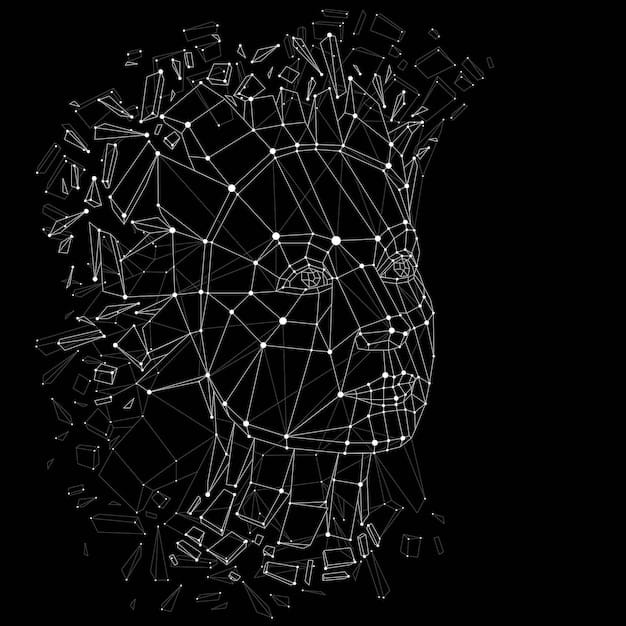US Brain-Computer Interfaces: Latest Advancements Unveiled

The latest advancements in US-based brain-computer interfaces are revolutionizing neurological care and human augmentation, pushing boundaries in prosthetic control, communication for the disabled, and the fundamental understanding of brain function through innovative neural decoding and minimally invasive techniques.
Delving into the realm of neurological innovation, what are the latest advancements in US-based brain-computer interfaces? These cutting-edge technologies are rapidly transforming our understanding of the brain and offering unprecedented possibilities for medical treatment, rehabilitation, and even human augmentation. Join us as we explore the dynamic landscape of BCIs, from groundbreaking clinical trials to the ethical considerations that shape their future.
Understanding Brain-Computer Interfaces (BCIs)
Brain-Computer Interfaces (BCIs) represent a burgeoning field where human thought directly interacts with external devices. These systems translate neural activity into commands, bypassing the body’s natural neuromuscular pathways. This direct bridge between mind and machine holds immense promise, particularly within the United States, given its robust research ecosystem and significant investment in neurotechnology.
The core concept of a BCI often revolves around sophisticated signal acquisition and processing. Electrodes, whether placed on the scalp (EEG), on the surface of the brain (ECoG), or implanted directly into brain tissue (intracortical arrays), capture electrical signals generated by neurons. These signals are then amplified, filtered, and decoded by algorithms to discern user intent, enabling control over prosthetics, communication devices, or even virtual environments.
Types of BCIs and Their Evolution
The evolution of BCIs has seen a progression from rudimentary lab demonstrations to increasingly refined and clinically relevant applications. This journey highlights a continuous pursuit of greater signal fidelity, reduced invasiveness, and enhanced user experience.
- Non-Invasive BCIs: EEG-based systems are the most common type, offering safety and ease of use. They are extensively used in research for cognitive studies and in some commercial applications for gaming or meditation, though their spatial resolution and signal quality are limited.
- Partially Invasive BCIs: Electrocorticography (ECoG) involves placing electrodes on the surface of the brain, underneath the dura mater. This provides better signal fidelity and bandwidth than EEG, with lower surgical risks than fully invasive approaches, making them attractive for clinical applications.
- Invasive BCIs: Intracortical microelectrode arrays penetrate the brain tissue to record from individual neurons or small clusters. These systems offer the highest spatial resolution and signal-to-noise ratio, enabling highly precise control of external devices. They are crucial for advanced prosthetic control but come with inherent surgical risks and long-term stability challenges.
Each type presents unique trade-offs between signal quality, invasiveness, and long-term viability, driving research towards balancing these factors for practical, sustained use. The choice of BCI type largely depends on the intended application and the patient’s specific needs, with the US being a global leader in advancing all three categories.
Neural Decoding Breakthroughs
At the heart of any effective BCI lies the ability to accurately interpret brain signals, a process known as neural decoding. Recent years have witnessed remarkable breakthroughs in this area, significantly enhancing the precision and responsiveness of BCI systems developed in the US. These advancements are not merely incremental; they represent fundamental shifts in how we understand and translate the complex language of the brain.
Sophisticated machine learning algorithms, particularly deep learning models, are now adept at identifying intricate patterns within neural data that previously eluded simpler methods. These algorithms can learn to predict intended movements, speech, or even emotional states from raw brain activity, far surpassing the capabilities of earlier linear decoders. This improved decoding accuracy is critical for applications requiring fine motor control or nuanced communication.
Furthermore, researchers are exploring hybrid decoding approaches that combine different types of neural signals or integrate BCI data with other physiological inputs. This multi-modal approach can compensate for the limitations of a single signal source, leading to more robust and reliable BCI performance in real-world environments. The ultimate goal is to create a seamless, intuitive interaction between the user and the BCI, making the technology feel like a natural extension of their own body.
Advancements in Machine Learning for BCI
The synergy between BCI research and machine learning has been particularly transformative. Deep neural networks, inspired by the brain’s own structure, are exceptionally good at discovering complex relationships in high-dimensional data, which is precisely what neural recordings represent. This has opened new frontiers in decoding brain activity.
- Convolutional Neural Networks (CNNs): Used for pattern recognition in spatial neural data, such as identifying motor cortex activity for movement intention.
- Recurrent Neural Networks (RNNs) and LSTMs: Excellent for processing sequential data, like the temporal patterns of neural spikes during speech or continuous movement.
- Generative Adversarial Networks (GANs): Explored for synthesizing realistic brain signals or enhancing the quality of recorded data, though still largely in experimental stages for BCI.
The development of these sophisticated models requires massive datasets of neural activity, which US research institutions are uniquely positioned to collect and process. The focus is also shifting towards online, adaptive learning algorithms that can continuously improve decoder performance as the user interacts with the BCI, adapting to changes in neural activity over time.

Minimally Invasive and Non-Invasive BCI Technologies
While invasive BCIs offer unparalleled signal quality, their surgical requirements and associated risks present significant barriers to widespread adoption. Consequently, a major thrust in US BCI research is the development of less invasive or entirely non-invasive technologies that can still deliver clinically meaningful performance. This focus aims to expand the accessibility of BCI technology to a broader patient population.
Researchers are exploring novel electrode materials and designs that can be implanted with less traumatic procedures, or even entirely without cranial surgery. These include flexible electrode arrays that conform to the brain’s surface, requiring only a small incision, and injectable or wirelessly powered micro-implants designed for minimal intrusion. The goal is to reduce infection risk, improve long-term stability, and shorten recovery times, making BCI technology a more viable option for chronic conditions.
Beyond partially invasive methods, significant progress is being made in enhancing non-invasive BCI performance. Advanced signal processing techniques are being applied to EEG data to extract more robust and reliable control signals. Furthermore, hybrid non-invasive systems combining EEG with other modalities like functional near-infrared spectroscopy (fNIRS) or eye-tracking are showing promise in improving accuracy and user experience. These innovations are crucial for moving BCIs out of specialized labs and into everyday life.
Emerging Non-Surgical Approaches
The quest for non-surgical yet effective BCI solutions is driving innovation in several directions, leveraging diverse biophysical principles:
- High-Density EEG: Utilizing a greater number of electrodes distributed across the scalp to improve spatial resolution of brain activity, making EEG signals more precise for BCI control.
- Ultrasound Neuromodulation: Exploring focused ultrasound waves to stimulate or record brain activity non-invasively, offering a potential pathway for deeper brain interfaces without surgery.
- Optical Imaging (fNIRS): Measuring changes in blood oxygenation related to neural activity. While slower than electrical signals, fNIRS can provide insights into brain function suitable for some BCI applications, particularly in rehabilitation or cognitive training.
These emerging non-surgical approaches are particularly valuable for applications where permanent implantation is not feasible or desired, such as consumer-grade devices or short-term therapeutic use. The US scientific community is at the forefront of these explorations, seeking to balance performance with patient comfort and safety.
Clinical Applications and Patient Impact
The primary driver behind much of the BCI research in the US is the profound potential to restore function and improve the quality of life for individuals with severe neurological disorders. From enabling communication for those with locked-in syndrome to restoring mobility for amputees or paralyzed individuals, BCIs are moving from experimental procedures to transformative clinical tools.
One of the most impactful applications is in the realm of motor prosthetics. Patients with paralysis or limb loss are learning to control advanced robotic arms and hands with their thoughts, allowing them to perform complex tasks like eating, drinking, or even feeling sensations from the prosthetic. These demonstrations highlight a future where physical limitations imposed by injury or disease can be significantly overcome through neurotechnology.
Another crucial area is communication. For individuals who have lost the ability to speak due to conditions like ALS or stroke, BCIs offer a new voice. By decoding neural activity associated with intended speech or text generation, these systems enable users to communicate with their families and caregivers, breaking debilitating barriers of isolation. The continued development and refinement of these clinical applications remain a paramount focus for US researchers and clinicians.
Transformative Medical Breakthroughs
The impact of BCI technology extends across multiple medical conditions, demonstrating tangible benefits for patients:
- Restoring Motor Function: Patients with spinal cord injuries or limb amputations can regain independence using thought-controlled robotic limbs and exoskeletons.
- Enabling Communication: For conditions like locked-in syndrome, ALS, or severe stroke, BCIs provide vital avenues for communication, allowing patients to interact with their environment.
- Treating Neurological Disorders: Research is exploring BCIs for managing symptoms of Parkinson’s disease, epilepsy, and even mental health conditions like severe depression, by directly modulating brain activity.
These clinical successes, often spearheaded by US institutions, underscore the life-changing potential of BCIs. They are not merely tools but extensions of patient capabilities, fostering greater autonomy and social engagement.
Ethical Considerations and Future Outlook
As brain-computer interfaces advance, particularly within the US, they raise a host of complex ethical, legal, and societal questions that demand careful consideration. While the potential benefits are immense, it is imperative to address the implications of technology that directly interfaces with the human brain.
Concerns revolve around issues such as privacy and data security—who owns the neural data? How will it be protected from misuse or hacking? There are also questions regarding agency and identity, particularly if BCIs begin to influence decision-making or personality. Ensuring equitable access to these life-changing technologies is another critical ethical challenge, preventing a “neuro-divide” where only the privileged can benefit.
The future of BCIs holds incredible promise, but its responsible development requires ongoing dialogue among scientists, ethicists, policymakers, and the public. In the US, regulatory bodies are beginning to grapple with how to oversee BCI research and product development, balancing innovation with patient safety and ethical guidelines. This proactive approach will be essential to foster public trust and ensure that BCI technology serves humanity’s best interests.
Navigating the Ethical Landscape
The ethical framework surrounding BCIs is rapidly evolving. Key areas of discussion include:
- Data Privacy and Security: Neural data is highly sensitive. Robust cybersecurity measures and clear regulations are needed to protect this information from unauthorized access or commercial exploitation.
- Identity and Autonomy: As BCIs become more sophisticated, questions arise about how they might influence a user’s sense of self, agency, and decision-making capabilities.
- Equitable Access: Ensuring that BCI technologies are affordable and accessible to all who could benefit, regardless of socioeconomic status, is a long-term challenge.
Addressing these ethical dilemmas proactively, through interdisciplinary collaboration and public engagement, is vital for the societal acceptance and responsible integration of BCIs.
Funding and Research Landscape in the US
The strong momentum in US-based BCI advancements is heavily propelled by substantial funding from both government agencies and private entities, alongside a vibrant research ecosystem. The convergence of academic excellence, technological innovation, and venture capital creates a fertile ground for breakthroughs in neurotechnology.
Key government agencies like the National Institutes of Health (NIH) and the Defense Advanced Research Projects Agency (DARPA) have historically been pivotal in funding foundational and applied BCI research. NIH programs often focus on clinical translation and understanding neurological disorders, while DARPA drives ambitious projects aimed at immediate, high-impact solutions for individuals with disabilities, particularly veterans. These investments provide the long-term, stable support necessary for high-risk, high-reward scientific endeavors.
Concurrently, private investment has surged, with a growing number of startups and established tech companies entering the BCI space. This private sector involvement often accelerates the transition from laboratory prototypes to market-ready products, bringing engineering expertise and scaling capabilities. The collaborative environment between universities, government labs, and industry is a unique strength of the US BCI landscape, fostering rapid innovation cycles.
Key Players and Collaborative Efforts
The US BCI research landscape is characterized by a network of leading institutions and collaborative initiatives:
- Academia: Major universities like Stanford, Brown, and the University of Pittsburgh are home to world-renowned BCI research centers, pushing the boundaries of fundamental and applied science.
- Government Agencies: NIH provides significant grants for clinical BCI trials and basic neuroscience, while DARPA funds highly innovative projects for neural prosthetics and human performance augmentation.
- Private Sector: Companies such as Neuralink, Synchron, and Blackrock Neurotech are actively developing and commercializing BCI devices, attracting substantial private investment and talent.
These diverse entities frequently collaborate through research consortia, shared data initiatives, and joint ventures, creating a powerful synergy that accelerates the pace of BCI discovery and translation.
Challenges and Opportunities Ahead for US BCI
Despite the remarkable progress, the field of Brain-Computer Interfaces in the US still faces several significant challenges. Overcoming these hurdles will be critical for the widespread adoption and long-term success of BCI technology, transitioning from niche clinical applications to more broadly accessible solutions.
One primary technical challenge is achieving long-term stability and reliability of implanted devices. Biocompatibility issues, signal degradation over time, and the need for frequent recalibration continue to be areas of intensive research. Developing systems that can operate robustly for decades without requiring invasive maintenance is essential for patients needing permanent neuroprosthetic solutions. Furthermore, enhancing the information transfer rate and decoding accuracy for complex tasks remains an ongoing quest, particularly for non-invasive systems.
On the regulatory and commercial fronts, navigating the complex pathways for FDA approval and ensuring cost-effectiveness are major considerations. Opportunities lie in expanding BCI applications beyond severe disability to areas such as cognitive enhancement, mental health management, and virtual reality interfaces. These broader applications could drive down costs and accelerate technological refinement, ultimately benefiting a wider spectrum of users and cementing the US’s leadership role in this transformative field.
Overcoming Hurdles and Seizing Potential
Addressing the current limitations will unlock vast new possibilities for BCI technology:
- Biocompatibility and Longevity: Developing new materials and implantation techniques to ensure devices remain functional and safe within the brain for extended periods.
- User Training and Adaptability: Creating intuitive training protocols and adaptive algorithms that allow users to quickly learn BCI control and for the systems to adjust to individual neural variations.
- Ethical Governance: Establishing clear ethical guidelines and regulatory frameworks that foster responsible innovation while protecting user rights and privacy.
By systematically tackling these challenges, the US BCI ecosystem is poised to capitalize on the immense opportunities to enhance human capabilities and address pressing medical needs, steering the future of neurotechnology.
| Key Point | Brief Description |
|---|---|
| 🧠 Neural Decoding | Breakthroughs in machine learning enhance accuracy in interpreting brain signals for BCI control. |
| 🏥 Clinical Impact | BCIs are transforming lives by restoring motor function and communication for patients with neurological conditions. |
| 🛡️ Ethical Debate | Discussions around data privacy, autonomy, and equitable access are crucial for responsible BCI development. |
| 🔬 Research Funding | Significant public and private investments fuel rapid innovation in US BCI research. |

Frequently Asked Questions About US-Based Brain-Computer Interfaces
▼
The primary goal is to develop technologies that restore function and improve the quality of life for individuals with neurological disorders, such as paralysis or communication impairments. Additionally, research explores potential applications in human augmentation and mental health treatment, aiming to create seamless, intuitive connections between the brain and external devices.
▼
US-based BCIs help paralyzed individuals by enabling them to control prosthetic limbs, exoskeletons, or computer cursors directly with their thoughts. By decoding neural signals related to movement intention, these systems bypass damaged spinal cord pathways, restoring a degree of independence and interactivity with their environment.
▼
Generally, non-invasive BCIs (like EEG) are safer and easier to use but offer lower signal fidelity and spatial resolution compared to invasive methods (like intracortical implants). While significant advancements are improving non-invasive performance, invasive BCIs still typically provide more precise and rapid control for complex tasks due to their direct access to neuronal activity.
▼
Key ethical concerns include the privacy and security of neural data, potential impacts on a user’s identity and autonomy, and ensuring equitable access to these technologies. Researchers and policymakers are working to establish guidelines that balance innovation with patient safety and societal well-being as BCI technology becomes more advanced.
▼
Major players include leading academic institutions (e.g., Stanford, Brown), government agencies (e.g., NIH, DARPA) funding research, and a growing number of private companies (e.g., Neuralink, Synchron, Blackrock Neurotech) developing and commercializing BCI devices. This collaborative ecosystem fosters rapid advancements from research to clinical application.
Conclusion
The landscape of US-based Brain-Computer Interfaces is one of dynamic innovation and profound potential. From breakthroughs in neural decoding powered by advanced machine learning to the relentless pursuit of less invasive technologies, the advancements are swiftly moving BCIs from the realm of science fiction to tangible clinical realities. As research continues to push the boundaries of what’s possible, addressing the accompanying ethical and accessibility considerations will be paramount to ensuring these transformative technologies benefit all of humanity. The collaborative spirit among US academic, governmental, and private sectors underscores a commitment to leading the charge in this revolutionary field, promising a future where neural interfaces empower individuals and deepen our understanding of the human mind.





